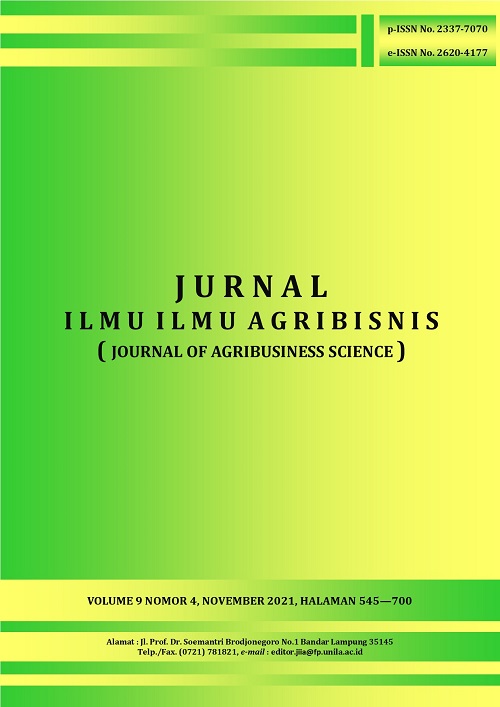ANALISIS USAHATANI DAN FAKTOR-FAKTOR YANG MEMPENGARUHI KEUNTUNGAN USAHATANI CABAI MERAH DI KECAMATAN TULANG BAWANG TENGAH KABUPATEN TULANG BAWANG BARAT
DOI:
https://doi.org/10.23960/jiia.v9i4.5395 Abstract View: 475
Abstract View: 475
Abstract
This study aims to analyze farming and factors that affecting the profit of red chilli farming in Tulang Bawang Tengah Sub-District, Tulang Bawang Barat Regency. This research uses survey method. The research is located in Tulang Bawang Tengah Sub-Distric, Tulang Bawang Barat Regency, which was conducted in April-May 2019. The number of respondent are 57 farmers taken by random sampling method. Data are analyzed using quantitative and qualitative analysis. Furthermore, farming analysis is analyzed using income analysis and by counting the value of R/C to cash cost and total cost. Factors affecting profit function are analyzed by profit analysis UOP (Unit Output Price), which is a derived of the cobb douglas production function and normalized by output price. The results show that the average income of red chilli farming in Tulang Bawang Tengah Sub-District base on cash costs and the total cost is Rp47,486,701.79/hectare and Rp22,229,238.35/hectare, respectively. Red Chilli farming give a profit as the value of R/C to cast costs and total cost are 1,99 and 1,33. Factors of land area, seed price, SP36 fertilizer price, manure price, NPK fertilizer price, insecticide price, fungicide price and labor wages significantly affect to the profits of red chilli farming in Tulang Bawang Tengah Subdistric.
Keywords : income, profit, and red chilli
Downloads
Downloads
Published
How to Cite
Issue
Section
License
Authors who publish with this journal agree to the following terms:
Authors retain copyright and grant the journal right of first publication with the work simultaneously licensed under a Creative Commons Attribution License that allows others to share the work with an acknowledgement of the work's authorship and initial publication in this journal.
Authors are able to enter into separate, additional contractual arrangements for the non-exclusive distribution of the journal's published version of the work (e.g., post it to an institutional repository or publish it in a book), with an acknowledgement of its initial publication in this journal.
Authors are permitted and encouraged to post their work online (e.g., in institutional repositories or on their website) prior to and during the submission process, as it can lead to productive exchanges, as well as earlier and greater citation of published work (See The Effect of Open Access).














